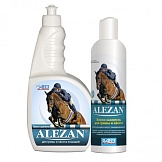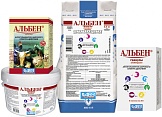Fumiklin fungicidal smoke generator
Benefits:
- Generation of fungicidal smoke allows the components to penetrate into the most inaccessible places of livestock and poultry houses
- It can be combined with other disinfectants, including for antimicrobial treatment, which provides complete disinfection of veterinary surveillance facilities
- Easy to use - just insert the fuse into the center hole of the generator
- One smoke generator can process 50 m3 of the veterinary surveillance facility
Fumichlin fungicidal smoke generator in 1 generator as fungicidal components contains enilconazole and thiabendazole.
Fungicidal agent Fumicholine fungicidal smoke generator has a broad spectrum of antifungal action against fungi, yeasts and their spores, including Aspergillus spp., Trichophyton verrucosum, T. mentagrophytes, T. equinum, Microsporum canis, M. gypseum.
Fumichlin fungicidal smoke generator is used for antifungal disinfection of rooms, bedding, incubators, hatchers, feeders, cages, nests, drinking bowls, utilities in poultry and livestock houses, rabbit breeding farms and stables.
It refers to moderately hazardous substances (hazard class 3 according to GOST 12.1.007), in recommended concentrations for use it does not have a local irritant, resorptive-toxic and sensitizing effect, does not cause irritation of the mucous membranes.
Recommendations for use.
Before disinfection it is necessary to carry out a thorough mechanical cleaning of the room, isolate the room, turn off the ventilation.The treatment is carried out in the absence of animals and birds. When carrying out the processing, the estimated number of smoke generators should be placed on the refractory surface as far as the stop, insert the fuse (match) with the lower end into the central
hole generator and ignite the fuse. One smoke generator is designed for 50 m3 of room volume. The exposure is, depending on the surface profile, from 12 to 24 hours (smooth and rough). If it is possible to re-infect fungal infection, additional treatments are carried out at intervals of 2-3 days until the threat of contamination is removed.
Adverse events.
Individual sensitivity to components is possible.Special instructions.
When working with a fumicidal agent Fumichlin fungicidal smoke generator, the usual personal hygiene and safety measures for use with disinfectants should be observed (use sun-sunglasses, gloves and a respirator). The smoke generator easily ignites and quickly becomes hot. It is not recommended to touch the empty smoke generator with bare hands for 15 minutes after ignition. Fumicholine fungicidal smoke generator can be combined with other disinfectants for simultaneous antimicrobial and antifungal treatment.Storage.
Store the product in the manufacturer's closed packaging, in a dry place, protected from direct sunlight, away from open flames and heating appliances, separately from food and feed, at temperatures from 0 ° C to 30 ° C. Shelf life in the manufacturer's unopened package is 2 years from the date of manufacture.Form of issue.
Let out the means put up 34 g in cardboard smoke generators, equipped with a fuse, placed on 1, 2. 4, 5, 6, 10 and 20 pieces in a cardboard box; 18 pieces in a cardboard box.
The information provided in this catalog is for reference only. There may be some changes in the characteristics, packaging and packaging of products.
AVZ reserves the right to make such changes without notice. You can get full information about the updated products from your personal manager or your nearest AVZ dealer.
All drugs for veterinary use from this catalog may be contraindicated and when using it is necessary to familiarize yourself with the Instructions for Use.






.webp)







